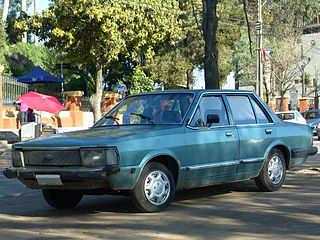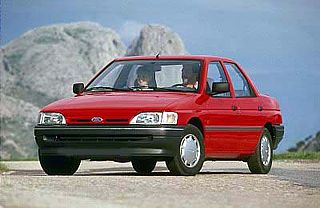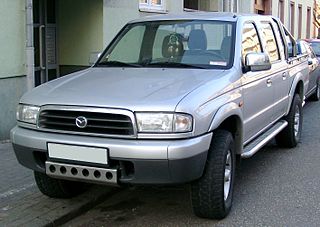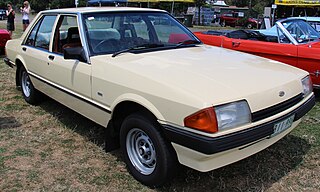
The Ford Sierra is a mid-size car or large family car manufactured and marketed by Ford Europe from 1982–1993, designed by Uwe Bahnsen, Robert Lutz and Patrick le Quément — and noted for its aerodynamic styling producing a drag coefficient of 0.34, a significant improvement over its predecessors.

The Ford Laser is a compact car, originally a subcompact car in the first three generations, which was sold by Ford in Asia, Oceania, and parts of South America and Africa. It has generally been available as a sedan or hatchback, although convertible, wagon and pick-up versions have also been available in different markets. The sedan, and briefly station wagon, versions were badged Ford Meteor in Australia between 1981 and 1987. The Ford Meteor name was also used in South Africa.

The Peugeot 504 is a mid-size, front-engine, rear-wheel-drive automobile manufactured and marketed by Peugeot from 1968 to 1983 over a single generation, primarily in four-door sedan and wagon configurations – but also as twin two-door coupé and cabriolet configurations as well as pickup truck variants.

The Ford Versailles was a mid-size automobile between 1991 and 1996 in Brazil and Argentina. It was a version of the Volkswagen Santana sold in the 1990s, when Ford and Volkswagen shared models in South America in a joint venture known as Autolatina. It replaced the Ford Del Rey in Brazil and the locally built Ford Sierra in Argentina. The station wagon version was sold as the Ford Royale.

The Volkswagen Gol is a subcompact car that has been manufactured by Volkswagen do Brasil since 1980 as Volkswagen's entry-level car in the Latin American market—where it succeeded the Volkswagen Type 1 (Fusca) and the Volkswagen Brasilia. Several variants of the Gol-derived Voyage and Parati were marketed in North America as the Volkswagen Fox from 1987 to 1993.

The Ford Corcel is a family car which was sold by Ford do Brasil in Brazil, Chile, Uruguay, Paraguay and Venezuela. It was also assembled in Venezuela. The French-influenced styling of the Corcel was unique to Brazil until late 1977. From this year, the redesigned Corcel II bore a strong resemblance to the European Ford Escort and Ford Cortina of same era, but its Renault underpinnings remained the same. The Corcel was eventually replaced by the Del Rey, which was originally introduced as a better equipped version of the Corcel.

The Ford Del Rey is a midsized car produced by Ford do Brasil in Brazil from 1981 to 1991. It was a successor to the popular Ford Corcel II. Like the Corcel II, the Del Rey was designed exclusively for Brazil, but was sold in Chile, Venezuela, Uruguay, and Paraguay, as well.

The Ford Verona and Volkswagen Apollo are a pair of small family cars that were manufactured in Brazil by Autolatina, a joint venture between Brazilian subsidiaries of Ford and Volkswagen. The Verona was produced from 1989 to 1992 and from 1993 to 1996, initially as a direct replacement for the ageing Ford Del Rey.

The Chevrolet El Camino is a coupé utility vehicle that was produced by Chevrolet between 1959–60 and 1964–1987. Unlike a standard pickup truck, the El Camino was adapted from the standard two-door Chevrolet station wagon platform and integrated the cab and cargo bed into the body.

Ford Courier is a model nameplate used by Ford since the early 1950s. The Courier moniker has been used on a variety of vehicles all around the world since it was first used in North America for a sedan delivery. The Courier nameplate was also used by Ford for a series of compact pickup trucks and would also see use by Ford of Europe denoting a Fiesta-based panel van. Ford Brazil used the nameplate for a Fiesta-based coupe utility pickup marketed across Latin America.
The Ford CHT engine is an inline four-cylinder internal combustion engine produced by the Ford Motor Company in Brazil during the 1980s and 1990s. It was based on the Renault Cléon-Fonte engine introduced in 1962. It is unrelated to the similarly-named Ford CVH engine.

The Ford Galaxy is a seven-seater car produced by Ford of Europe from June 1995 to April 2023. Considered in the motor industry to be a large multi-purpose vehicle (MPV), it was the first Ford-brand MPV produced and marketed outside of North America, the model line is currently in its third generation. Sharing its platform architecture with the Ford Mondeo, the Galaxy was developed alongside the Ford S-Max; the model line is slotted between the Connect and Custom variants of the Ford Tourneo/Transit model family.

The Mazda B series is a series of pickup trucks that was manufactured by Mazda. Produced across five generations from 1961 to 2006, the model line began life primarily as a commercial vehicle, slotted above a kei truck in size. Through its production, Mazda used engine displacement to determine model designations; a B1500 was fitted with a 1.5 L engine and a B2600, a 2.6 L engine.

The FSO Polonez is a motor vehicle that was developed in Poland in collaboration with Fiat and produced by Fabryka Samochodów Osobowych from 1978 to 2002. It was based on the Polski Fiat 125p platform with a new hatchback design by Giorgetto Giugiaro. It was available in a variety of body styles that included two- and four-door compact-sized cars, station wagons, as well as commercial versions that included pickup truck, cargo van, and ambulance versions. Production totaled more than one million units excluding the pickup truck and van variants. The Polonez was marketed in other nations and was popular in its domestic market until Poland joined the European Union in 2004.

The Ford Escort is a small family car that was manufactured by Ford of Europe from 1968 until 2000. In total there were six generations, spread across three basic platforms beginning with the original rear-wheel drive Mk.1/Mk.2 (1968–1980), the "Erika" front wheel drive Mk.3/Mk.4 (1980–1992), and the final CE-14 Mk.5/Mk.6 (1990–2002) version. Its successor - the Ford Focus - was released in 1998, but the final generation of Escort was gradually phased out, with the panel van version ending production in 2002 in favour of the Ford Transit Connect.

The Fiat Fiorino is a small commercial vehicle produced by the Italian car manufacturer Fiat since 1977. Its first two generations have been the panel van derivatives of other small models, such as the Fiat 127 and Fiat Uno, while the current third generation was developed jointly with PSA Peugeot Citroën, and is based on the Fiat Small platform.

The Volkswagen Brasília is a rear-engined compact car developed by Volkswagen do Brasil and internally designated as the Type 321. Named for Brazil's capital city, the car was manufactured and marketed by Volkswagen in Brazil from 1974 to 1982; in Mexico from 1975 to 1982; and built from knock down kits in Nigeria, where it was marketed as the Igala from 1976 to 1980.

Ford Brasil is the Brazilian subsidiary of American automaker Ford Motor Company, founded on April 24, 1919. The operation started out importing the Ford Model T cars and the Ford Model TT trucks in kit form from the United States for assembly in Brazil. The Ford brand, however, had already been present in the country since 1904 with both vehicles being sold in Brazil.

The Isuzu Faster is a pickup truck that was manufactured and marketed by Isuzu between 1972 and 2002 over three generations. The Faster was succeeded worldwide by Isuzu D-Max, except in Japan and North America.

The Ford Falcon (XE) is a full-size car that was produced by Ford Australia from 1982 until 1984. It was the second iteration of the fourth generation of the Falcon and also included the Ford Fairmont (XE)—the luxury-oriented version.





















